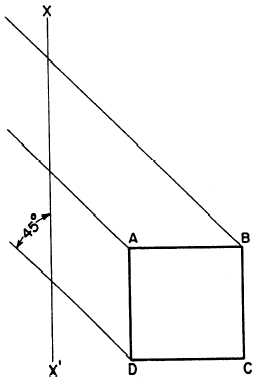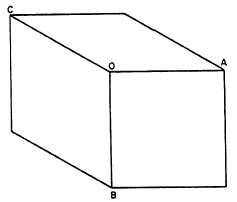may also be shown on this single plane by
constructing the receding projection lines of the
object at an angle other than perpendicular to the
plane of projection.
Figure 5-46 shows the same object by both
orthographic and oblique projection. The block
is placed so that its front surface (the surface
toward the plane of projection) is parallel to the
plane of projection. You can see that the
orthographic projection shows only this surface
of the block. The oblique projection, on the other
hand, shows the front surface and also the top
and side surfaces. The orthographic projection
shows only two dimensions: length and width. The
oblique projection shows three: length, width, and
thickness. Oblique projection, then, is one method
by which an object can be shown, in a single view,
in all three dimensions.
There are two types of oblique single-plane
projections: CAVALIER and CABINET.
Cavalier Projection
CAVALIER PROJECTION is a form of
oblique projection in which the projection lines
are presumed to make a 45-degree vertical and a
45-degree horizontal angle with the plane of
projection. Assume that in figure 5-47 the line
XX' represents a side-edge view of the plane of
projection, and that the square ABCD represents
a side of a cube, placed with its front face parallel
to, and its top face perpendicular to, the plane
of projection. You can see that the projected
lengths of AB and AD are the same as the actual
lengths.
Now assume that the line XX' in figure 5-47
represents a top-edge view of the plane of
Figure 5-46.—Oblique and orthographic projections of the
same object.
Figure 5-47.—Angle of projection lines in a cavalier
projection.
projection, and that the square ABCD represents
the top of the cube. You can see again that the
projected lengths of AB and AD are the same as
the actual lengths of AB and AD.
In a cavalier projection, then, any line parallel
to or perpendicular to the plane of projection is
projected in its true length. Figure 5-48 shows a
cavalier projection of the cube shown in figure
5-47. You start by drawing the axis, which
consists of the front axes OA and OB and the
receding axis OC. The front axes are always
perpendicular to each other; the receding axis
Figure 5-48.—Cavalier projection of a cube.
5-25





